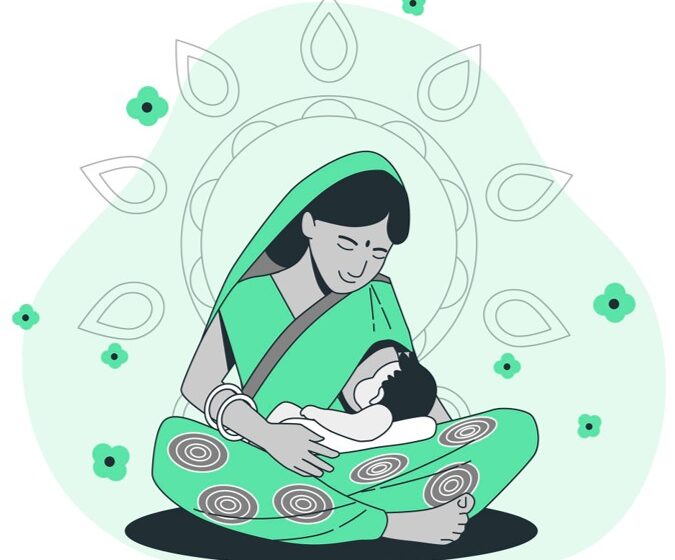Unfolding the Folds of Breast – World Breastfeeding Week 2021

Unfolding the Folds of Breast – World Breastfeeding Week 2021
World Breastfeeding Week is celebrated annually, and is observed every year from August 1 to 7 to motivate breastfeeding and uplift the health of mother and babies around the world . WHO states, breastfeeding is one of the most effective ways to ensure child health and survival. The theme of Breastfeeding Week- 2021 is ‘PROTECT BREASTFEEDING: A SHARED RESPONSIBILITY.
Let us begin with exploration of breast in every sphere on this breastfeeding week.
ANATOMY OF BREAST
Breast are large, modified sebaceous glands present bilaterally. These are also known as Mammary Gland. The breast is the tissue overlying the chest (pectoral) muscles. These constitutes the female accessory reproductive organ. These are mainly concerned with lactation following childbirth.
Women’s breast are made up of specialized tissue called as glandular tissue and fatty tissue. The glandular tissues produces milk. The part of the breast producing milk is organized into 15-20 sections, called Lobes. The smaller structures are present within each lobes, called as Lobules, where milk is produced. Network of tiny tubes constitutes the Ducts, through which milk travel. These ducts opens into larger ducts, which eventually comes out through the nipples. Nipple is surrounded by dark area of skin known as Areola.
PHYSIOLOGY OF BREAST
DEVELOPMENT– different changes are seen at different level of age group.
AT BIRTH- mammary gland is rudimentary and consists of tiny nipple.
AT CHILDHOOD– Till puberty, structure of male and female mammary gland is same.
AT PUBERTY– there is a major change in the structure of female mammary gland due to the influence of hormone. The beginning of changes in mammary gland is called THELARCHE. There is a growth of duct system and glandular tissues.
DURING PREGNANCY– in this phase, breast grows enormously in size due to hormone stimulation. Ducts system further develops with new alveoli. Areola becomes darker in color and also get enlarged.
ROLE OF HORMONES IN GROWTH OF MAMMARY GLAND
- Estrogen
- Progesterone
- Prolactin
- Placental hormones
- Other hormones like growth hormone, thyroxine, cortisol.
BREASTFEEDING
It is the process of feeding breast milk usually direct from the breast to your baby. This is also known as Nursing. It is exclusively recommended by American Academy of Pediatrics (AAP) and other medical experts for 6 months. This also led to the development of relation between mother and the baby. This process is associated with many benefits to baby as well as mother.
The first few days after birth, breasts make an ideal “first milk.” It’s called “ colostrums ”. Colostrum is thick, yellowish milk, helps a newborn’s digestive tract develop and prepare itself to digest breast milk. Colostrum is the first phase of breast milk, which changes over time to give your baby the nutrition they need as they grow. The second phase is called transitional milk. You’ll start to make transitional milk a few days after birth. You make this as your colostrum is gradually replaced with the third phase of breast milk, called mature milk, by 10 to 15 days after birth, you’ll make mature milk, which gives your baby all the nutrition they need.
1st Phase: Colostrums -> 2nd Phase: Transitional Milk -> 3rd Phase: Mature Milk
Is baby getting enough milk?
If baby is getting enough breast milk they should:
•Not lose more than 7% of their birth weight in the first few days after delivery
•Seem content for about 1-3 hours between feedings
•Have at least 6 diapers a day wet with very pale or clear pee by the time they are 7-10 days old.
BENEFITS OF BREASTFEEDING FOR THE BABY-
- Breast milk is a complete food containing all the essential nutrition.
- It has a perfect mixture of vitamins, proteins and fat needed for the growth of baby.
- It is more easy to digest than the infant formula
- It contains antibodies that help in fighting various bacterial and viral infections.
- These lowers the risk of asthma and allergies.
- Babies who are breastfed exclusively for first 6 months without any formula have fewer ear infections, respiratory illness and diarrhea.
- This also develops closure between mother and baby.
- These also reduces the risk of childhood obesity.
BENEFITS OF BREASTFEEDING FOR THE MOTHER
- It acts as a natural contraceptives
- It helps in losing pregnancy weight faster by burning the extra calories.
- It helps in the involution of uterus that is regaining the pre pregnant size of uterus.
- Reduces the chance of postpartum haemorrhage
- Also lowers the risk of developing breast, uterine and ovarian cancer.
PSYCHOLOGICAL ASPECT OF BREASTFEEDING-
Lactating is not just feeding and burping the baby. It is not just filling the stomach up and about gaining weight. The developing baby has a brain that needs to love. Newborn baby needs warmth in the arms of mother, food from her breast and a feeling of security in the knowledge of her presence.
As womb was a cushioned protective layer that nourishes the baby inside. Similarly, breast milk does the same work outside. It not only satisfy the hunger but also important for the development of bond between them and also helps in the psychological development as a separate being.
The mother’s milk contains immunoglobulins which is responsible for the development of immunity and prepares the body to face the world. Baby instinctively move towards mother’s breast and this lays ground for healthy connection with other people later in life.
By if any means this bonding is not fully established as mother was not emotionally available or the mother herself didn’t have a bond with her mother or there is a history of separation from mother during initial years of life. Then this impacts the child development of trust and security. These childs usually have great difficulty in connecting with other people
COMMON BREASTFEEDING PROBLEM AND ITS HOMEOPATHIC REMEDIES
Many mothers faced difficulty while breastfeeding. In fact babies also need time to learn this. They are not able to suck properly or difficulty in making a grip. These issues can be painful and disturbing, both to the mother and baby. Homeopathy works as a miracle in such case. Thus making this experience memorable and enjoyable.
- AGLACTIA- This is a condition in which breast fails to produce milk. Homeopathic remedies can be given in such condition for the milk production. Some are as follows
- Alfalfa- Very good remedy indicated for deficient lactation. This increase the quality and quantity of milk in nursing mothers.
- Agnus castus– Indicated for deficient milk secretion in nursing women with sadness.
- Asafoetida- Indicated for deficient milk secretion with oversensitiveness. Marked flatulence and regurgitation of liquids.
- Lecithinum– This is an excellent galactagogue. This makes the milk more nourishing and also increases the quantity.
- Lactuca virosa– True galactogogue. Increases the formation of milk in breast.
- Phosphoricum acidum– Indicated in woman with scanty milk secretion and also health is getting deteriorated by nursing.
- Parthenium hysterophorus– Indicated for increasing the flow of milk.
- Ricinus communis– Indicated for increasing the milk production in nursing women
- Spiranthes autumnalis– Indicated for milk flow in nursing women with drowsiness and spasmodic yawning.
- Yohimbinum– It causes the hyperemia of the milk glands and stimulates the function of lactation.
- PAINFUL BREAST/ MASTITIS–
- Aceticum acidum– Breast is painful, enlarged. Distended with milk.
- Borax– indicated for galactorrhea. While nursing, there is pain in opposite breast.
- Belladonna– Throbbing pain in breast with redness, streaks radiating from the nipple. Breast feels heavy, red and hard.
- Croton tiglium– Inflammation of breast. In nursing women, every suck of the child produces pain from the nipples to the back.
- Phellandrium– Indicated for pain in milk ducts which is intolerable between nursing. Pain in nipples.
- Phytolacca– Breast painful, hard and very sensitive and of a purple hue. When child nurses, pain radiates from the nipples to all over the body. Cracks and small ulcers around the nipples.
- SORE AND CRACKED NIPPLES-
- Agaricus– Indicated for itching and burning in nipples following parturition.
- Castor equi– Indicated for cracked, sore and ulcerated nipples. Excessively tender. Swelling of breast with violent itching. Red areola.
- Graphites– Indicated for hard and swollen breast. Nipples are sore, cracked and blistered.
- Silicea– Indicated for sore nipples which ulcerate easily. Nipples drawn in. fistulous ulcers of breast.
COMMON RUBRICS ASSOCIATED WITH BREAST
Few common rubric from the Kent Repertory that are related with breast and its conditions are mentioned here-
- [Chest] Abscess: Mammae: Nipples
- [Chest] Apthae of nipples, bleeding
- [Chest] Atrophy : of nipples
- [Chest] Bleeding nipples
- [Chest] Cracks of nipples
- [Chest] Cracks of nipples: Painful
- [Chest Discharge from nipple
- [Chest] Dryness: Nipples
- [Chest] Inflammation: Mammae: Nipples
- [Chest] Pain : Mammae: Nipples
- [Chest] Pain: Mammae: Nipples: Nursing while
- [Chest] Pain: Sore, bruised: Mammae: Nipples
- [Chest] Milk: Absent
- [Chest] Milk: Blood, with
- [Chest] Milk: Disappearing
REFERENCES
- webmd.com
- DC Dutta’s Textbook of Obstetrics
- Essentials of Medical Physiology, K Sembulingam & Prema Sembulingam
- Boericke’s New Manual of Homeopathic Materia Medica with Repertory
- Repertory Of The Homoeopathic Materia Medica, James Tyler Kent
P.S.: Do share your feedback about the above content in the comment section. Also mention any particular topic you would like to know about.
Note: We at The Homeopath take our ethics very seriously. More information about it can be found at Disclaimer page of our website.





